Tagged with 'Saltwater pearls'


The very latest news, musings and opinions from the world of Winterson. Quite simply, a celebration of a jewellery, fashion, culture and the business behind luxury.
-
Introducing the Lief Collection to Winterson
Introducing the Lief Collection to Winterson
This week we are delighted to launch a new collection of jewellery called Lief, which is also the old English word for "Beloved".
The newly launched Lief collection has been designed by our new Creative Director Alice Cicolini, who first began working with Winterson in 2013.
ALICE CICOLINI
Alice is a successful jewellery designer, creative commissioner and producer, with her work currently being stocked at Net-A-Porter, Dover Street Market, Urban Flower Grange Hall and Colette.
Her first collaborative collection with us called ‘Beau’ - a flamboyantly British range of seed pearl jewellery – is available exclusively at Winterson.
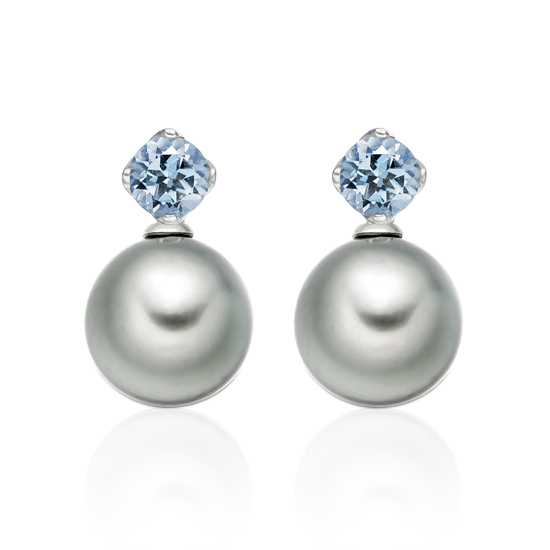
In her official Winterson role, Alice will be responsible for the creative conception and product development of the classic, bridal and fine jewellery collections at Winterson. She will also establish and manage our exclusive collaborations with other up and coming British designers.
Alice brings a distinctive style and influence to our jewellery that has already inspired our customers with her Beau collection, rings and earrings. We are delighted to welcome her fully to our team.
THE INSPIRATION FOR LIEF
The new Lief collection is based on the Winterson brand motif, which is inspired by a wild northern flower called Linnaea Borealis.

This little alpine twinflower is named Carl Linnaeus, a world renowned Swedish botanist who is also believed to have been the first to culture successfully a spherical cultured pearl.
Alice's designs for Lief are an exquisite fusion of colourful gemstones and diamonds with Winterson’s signature pearls. Clever interchangeable design allows the wearer to create different looks across the collection, from everyday to the more formal.
Three designs beautifully capture the essence of spring and colour and will be an exciting range of enduring classics to treasure.
LIEF, ENCHANTED AND ENTWINED
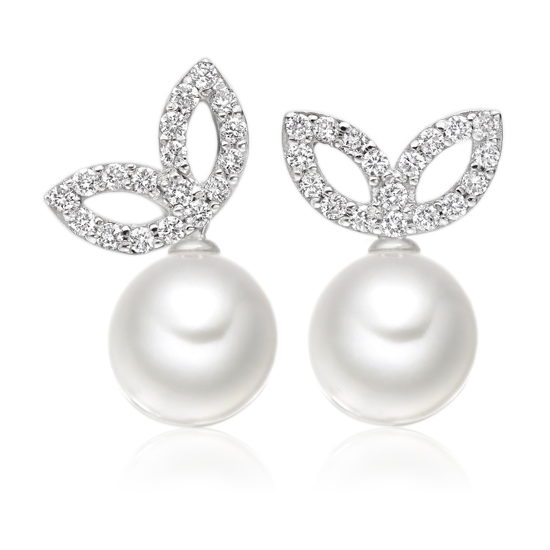
The new Enchanted Diamond Earrings sparkle with 36 ice clear gems and are finished in white and yellow gold. Stunning on their own, they can also be combined with a selection of our carefully chosen pearls, crafted with an 18 carat gold loop and expertly designed to fit the Lief stud earring earpost.
New elegantly understated studs also join the range with a beautiful selection of gemstones to tempt, from soft Morganite and Green Beryl, to vibrant Pink Tourmaline, Aquamarine and Amethyst. Each stud earring can be paired with white Akoya or Freshwater Drop pearls, naturally grey Tahitian pearls, or simply worn on their own.
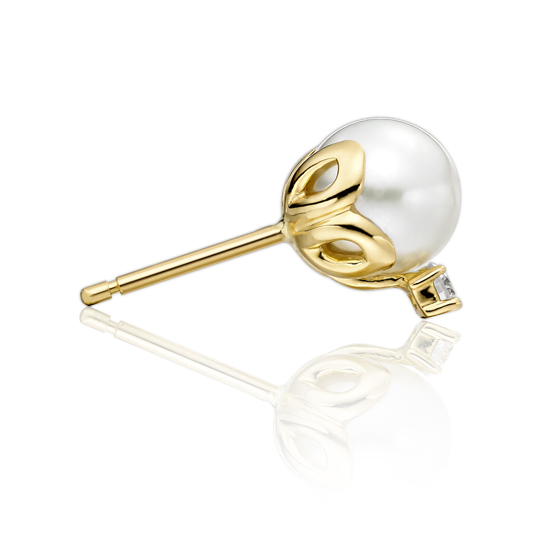
New Entwined Pearl Stud Earrings feature wild gold leaves, entwined around a pair of white Akoya pearls and adorned with two round white sparkling diamonds.
Discover the Lief collection here.
-
Embrace The Cold With The Luna Ice Ring
Embrace The Cold With The Luna Ice Ring
Introducing the latest addition to the Winterson range of exquisite pearl jewellery. The Luna Ice South Sea Pearl Ring, a timeless piece of jewellery with an irresistibly modern twist. A stunning addition to any Christmas wish list.
Capturing the spirit of winter time with its highly polished 18 carat white gold setting, ice-clear diamond and stunning South Sea pearl in purest, silvery white, the new Luna Ice ring is the product of our design work with up-and-coming British jewellery talent Alice Cicolini.
Cultured in ocean waters off the coasts of Australia and Indonesia, South Sea pearls are notable for their silky lustre. The perfectly round 8.5 mm pearl in the Luna Ice ring is perfectly complemented here by the subtle sparkle of the art-deco style baguette-cut diamond set beside it.
A new contemporary design to treasure. -
Fascinated by Pearls: William Saville-Kent
Fascinated by Pearls: William Saville-Kent
One of the most influential and unsung pioneers of the modern day cultured pearl industry was an Englishman called William Saville-Kent.
Many popularly associate Kokichi Mikimoto with the discovery of the technique to culture a spherical pearl in the early 20th century. But the intriguing truth of the race to discover how to mimic nature's process of creating a spherical pearl is far less clear, even today.
By the late 1890s, the pearling industry in Queensland, Australia was in real trouble. Although the sixth largest industry in Queensland in 1884, its export value had almost halved within the next 5 years. The coral and oyster beds off the northern coasts of Australia and the Torres Strait between Australia and New Guinea were sadly being depleted by divers and fishing fleets in search of valuable natural pearls and mother-of-pearl shell for use as buttons.
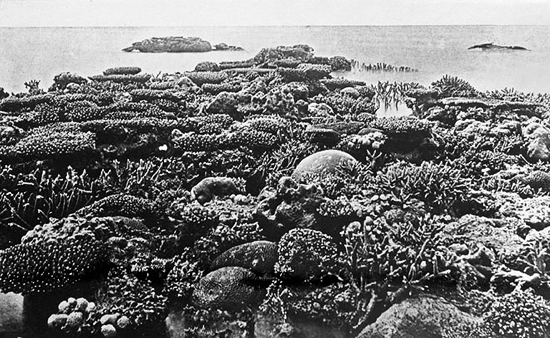
William Saville-Kent was a marine biologist with considerable experience of surveying and managing fish and oyster stocks. Over a period of 15 years, he was appointed by the British Colonial Government as Inspector of Fisheries in Tasmania (1884-87) and Commissioner of Fisheries for both Queensland (1889-92) and Western Australia (1892-95).
One of his main roles was to report on the increasingly difficult economic and environmental situation facing the pearling industry, introducing systems for licensing fishers, regulations for protecting the smaller sizes of the catch and creating protected government reserves for the longer-term sustainability of this natural resource.
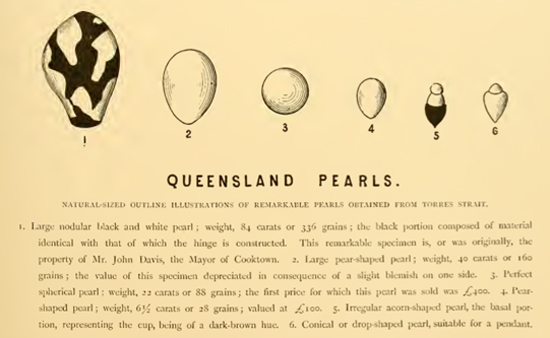
Saville-Kent was also a practical naturalist and was the first to recognise the difference between the silver and gold-lipped Pinctada maxima South Sea pearl oyster and the black-lipped Pinctada margaritifera cumingii Tahitian pearl oyster.
Beginning his experiments in 1889 at Thursday Island in the Torres Strait, the centre of the Queensland pearling industry, Saville-Kent would have been very aware of the impact that his work could have on the industry that he was so fascinated with. In this extract above from his 1893 book The Great Barrier Reef, he describes a single perfect spherical pearl (number 3) with a market value then of £400, worth approximately £40,000 adjusted for inflation today.
By 1891, Saville-Kent had successfully produced a number of cultured blister pearls and exhibited these in London. This was two years before Mikimoto had cultured five semi-spherical pearls in Japan.
Returning from London in 1905, with a syndicate called 'The Natural Pearl Shell Cultivation Company of London', a commercial cultured pearl farm was established near Torres Straits. Saville-Kent and his financial backers were convinced that they had the secret of how to produce a spherical cultured pearl.
There were by now others, however, with the same objective and this unique commercial and scientific race had begun...
-
What are Peacock Pearls?
What are Peacock Pearls?
The very name itself - Peacock Pearls - conjures up an image of an iridescent, beautiful gem with a myriad of shimmering colours. Are these pearls real and what are the qualities that give Peacock Pearls their colourful name?
A peacock pearl describes one of the most valued and sought after colours of a type of saltwater pearl called the Tahitian pearl, which are cultured in French Polynesia in the black-lipped oyster Pinctada margaritifera.
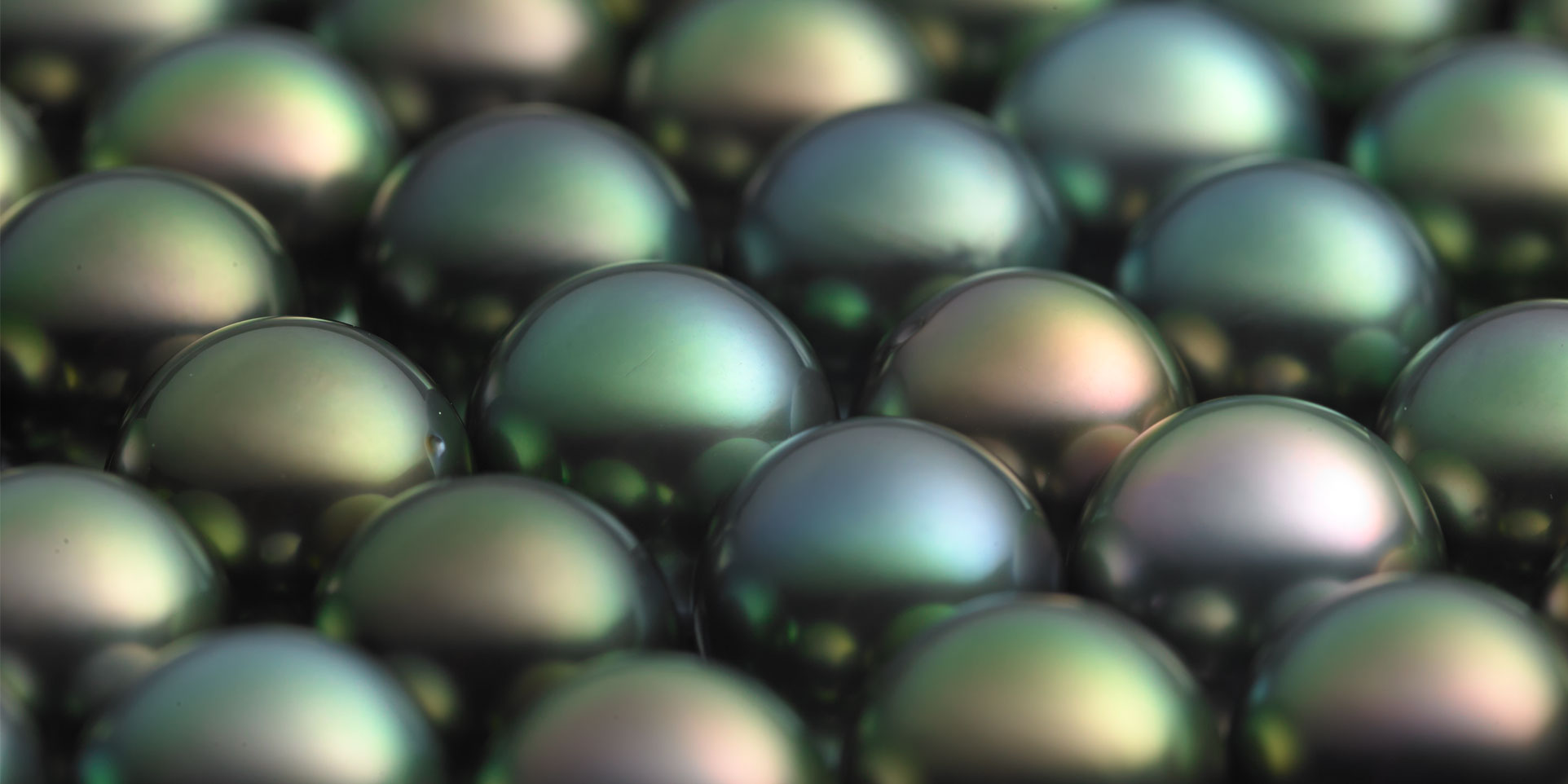
Image: Peacock Tahitian Pearls
With a dark grey-green body colour, a true peacock pearl will have a pink, purple or golden overtone of colour that appears to float on the surface of the pearl as the light catches it. These natural iridescent colours are achieved without any artificial dye or treatment.
What causes these special colours?
The dark body colour of the Tahitian pearl comes from the pigments and trace elements in the water that the oyster lives in.
The reason for the colour and strength of the overtone of each pearl, however, also depends on other factors. Scientists believe that the peacock's striking plumage is thought to be caused by the different ways that light is reflected at angles by the structure of the bird's feathers. Just as with the peacock, the layers of nacre on the curved surface of a pearl can have the same effect.
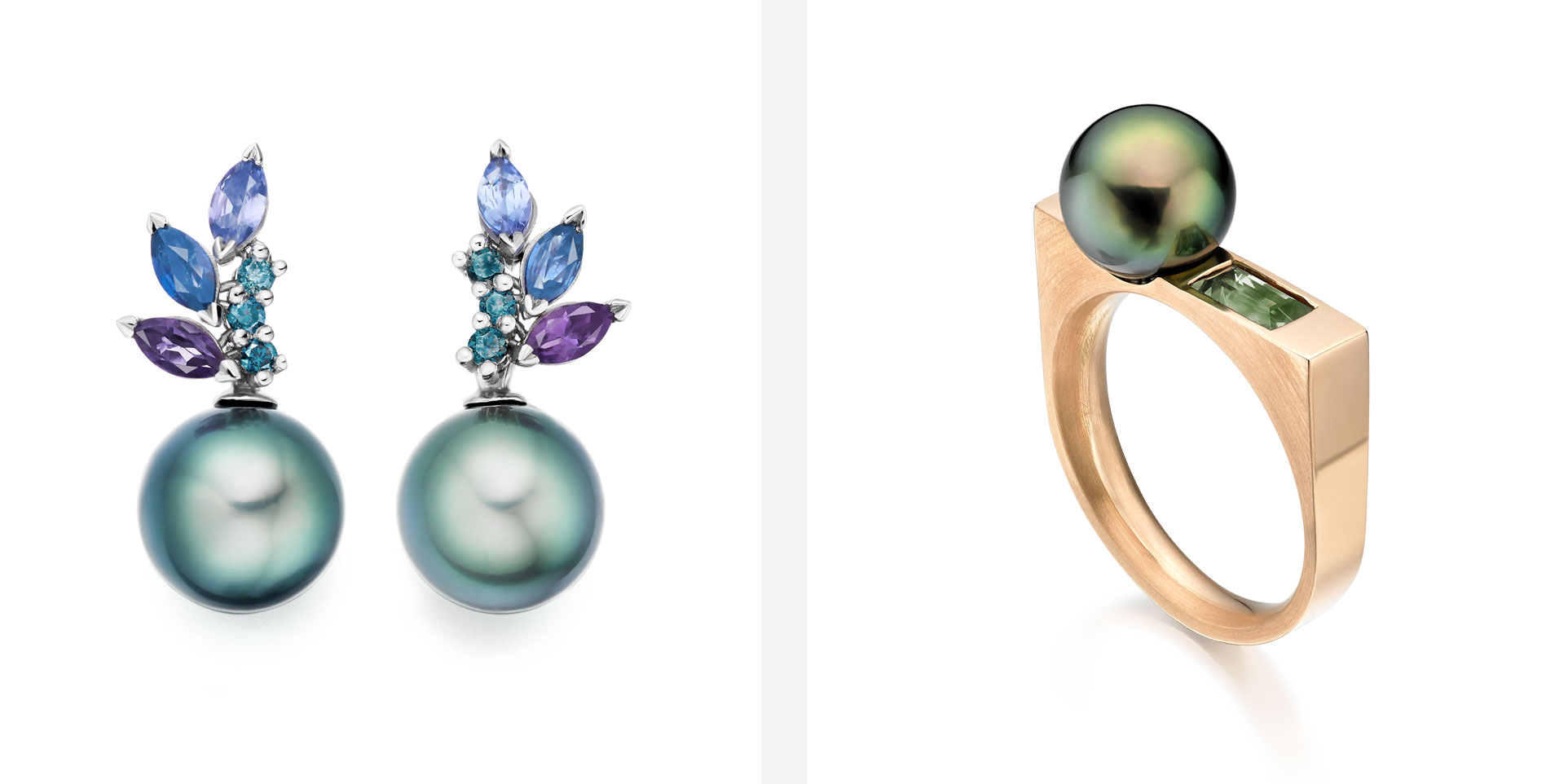
Image 1: Enchanted Lagoon Earrings in White Gold
Image 2: Luna Moss Tahitian Pearl and Sapphire Ring
Optical interference creates the complexity of each pearl's colour. The shape of the pearl, and the thickness and transparency of its nacre, can contribute in varying degrees to the colour's intensity.
Artificial colour treatments for peacock pearls
Since pearls were cultured early in the 20th century, there have been many attempts to reproduce artificially the peacock colours of a Tahitian pearl.
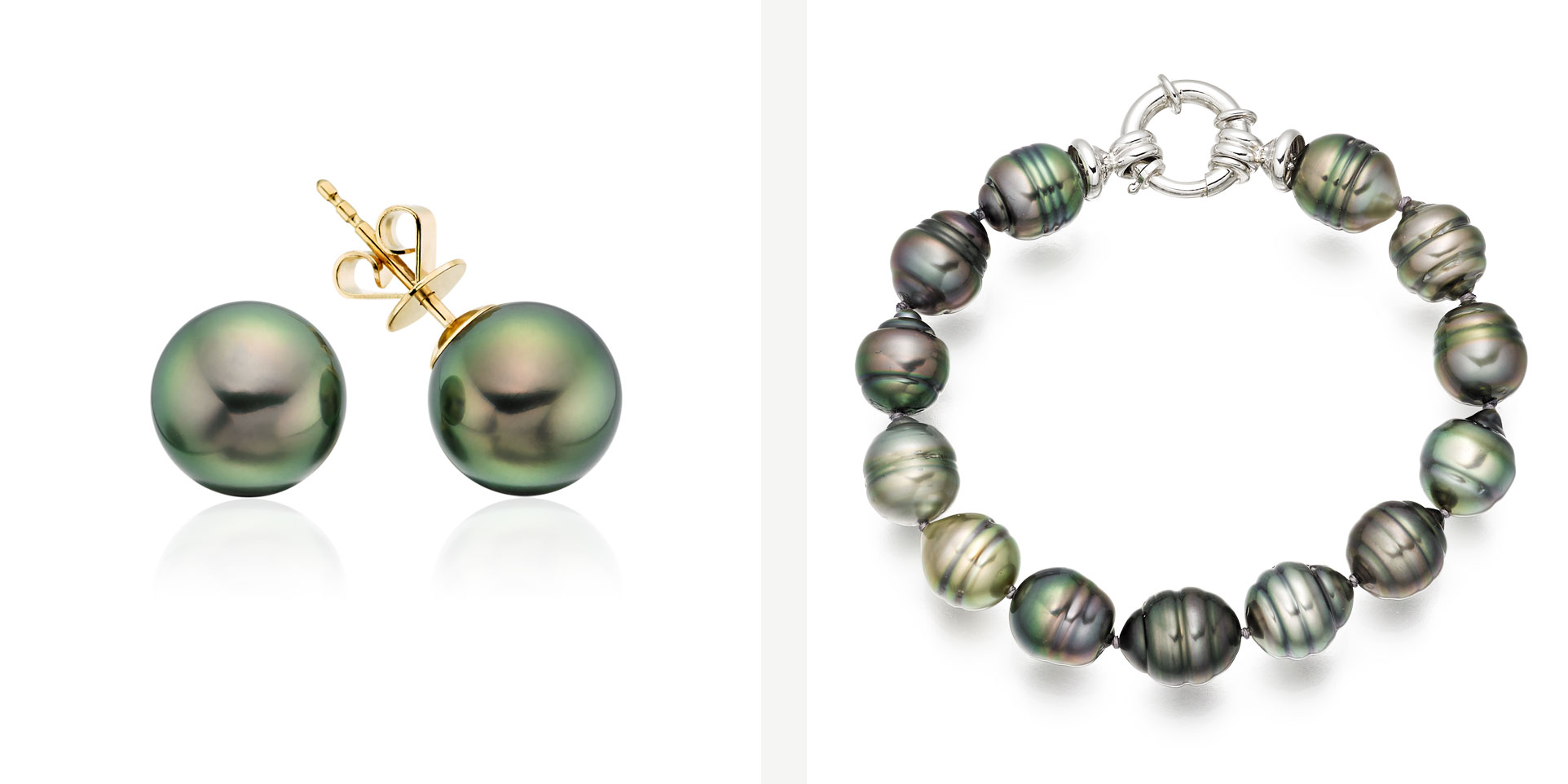
Image 1: Peacock Tahitian Pearl Stud Earrings in Yellow Gold
Image 2: Multi-coloured Baroque Tahitian Pearl Bracelet in White Gold
The exact techniques used are not well-known, but may involve the use of silver nitrate solutions to darken the pearl, other colouring agents such as organic dyes to produce a blue, purple, green or brown hue or gamma ray irradiation to darken the pearl itself.
Many black pearls sold today are Chinese freshwater pearls that have been treated. These treatments would be quite obvious to an experienced pearl expert or retailer as they are not an exact match to the real peacock colouring. Some dye treatments may also show some colour differences or fading over time, so ask your retailer if unsure.
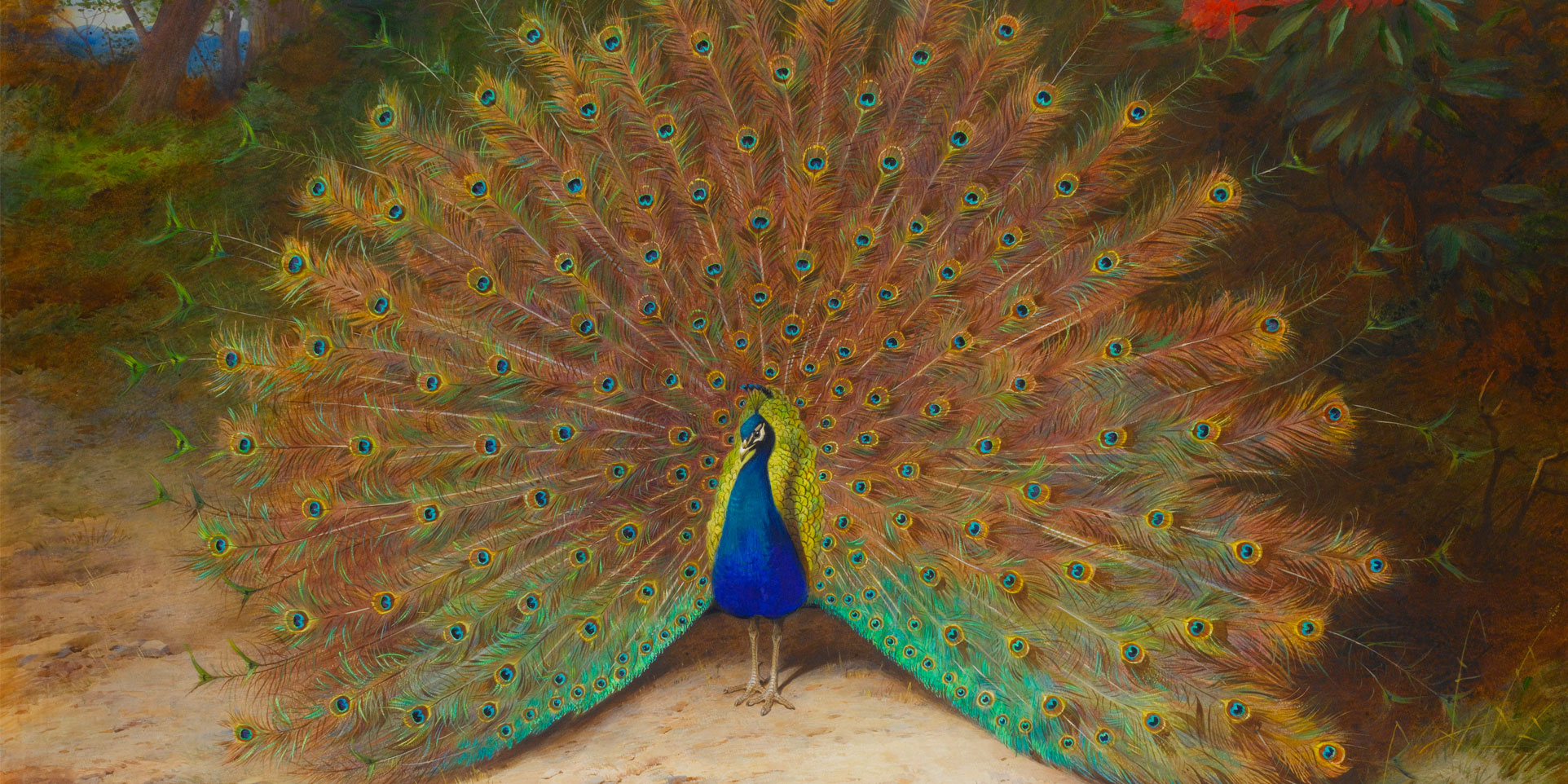
Image: Peacock and Peacock Butterfly, Archibald Thornburn, 19th century
Genuine Tahitian pearls are also prized for their relative rarity in comparison to freshwater pearls, and, like the silvery-white and golden South Sea pearls, are considered to be some of the finest examples of this extraordinary gem.
As with all rare pearls, this is reflected in their relative pricing, which is another way to distinguish this queen of gems from the dyed freshwater variety.
Proud as a peacock
We love the more natural colours and overtones of the peacock pearl and have a beautiful range of jewellery at Winterson that showcases the extraordinary natural rainbow overtones of these amazing peacock pearls.
Read our Journal article on Selecting Fine Pearls if you would like to know more.
-
Just Another Day Selecting Fine Pearls
Just Another Day Selecting Fine Pearls
Our buying team returned this week from Hong Kong with a new selection of fine pearls for our jewellery collections.
Hong Kong is the centre of the pearl business today, with dealers and pearl farmers from around the world sorting and selecting through the best (and the worst) of the new season's harvest of cultured pearls.
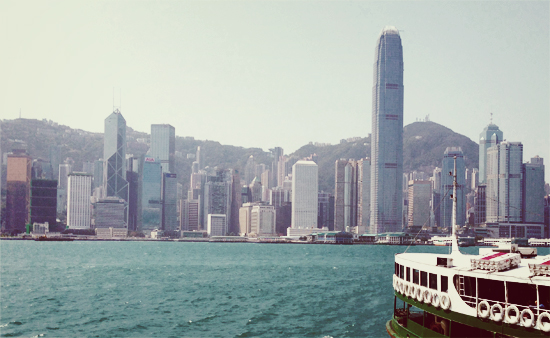
The size of this jewellery show also makes it one of the biggest in the world, with over 42,000 buyers from 140 different countries. Finished jewellery, brands and designers exhibit alongside the glittering distraction of rows upon rows of diamonds, precious gemstones and pearls.
With three main jewellery fairs in Hong Kong a year, the March and June exhibitions are the best time to view and select from the new harvest. This is because most pearls are harvested when the water is cool. Colder temperatures are believed to improve the quality of the lustre of the pearl.

Most sellers in the main part of the jewellery fair are wholesalers, but a number of the big pearl farmers and trade groups from the pearl producing regions of Tahiti, Australia and Indonesia also hold auctions by invitation to try and obtain the best prices for their new harvest.
In high demand this year were golden pearls from Myanmar, famed for their deep rich, burnt orangey golden colour. Prices for some pearls were reported to be reaching 5-8 times the seller's asking prices.
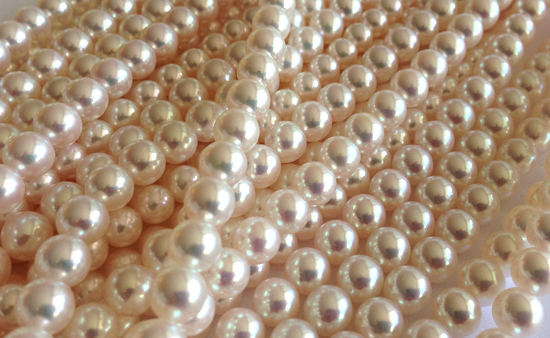
This is where it can take years of experience to be able to select a lot of fine pearls from the many others, recognising the excellent quality of nacre that gives the exceptional Akoya pearls above their mirror like shine, or the telltale signs of when a pearl's lustre is fading.
A typical pearl auction is held in a large quiet room away from the bustle of the main jewellery fair. Perhaps up to 300 or 400 different lots of loose pearls are arranged in bowls along long tables. Each lot will be comprised of between a few hundred to 5,000 individual pearls, sorted by shape, colour and quality, but usually mixed by size.
Buyers select a bowl that they are interested in, ask for it to be weighed and then search for a clear table with good, natural daylight to look at the pearls in each lot.
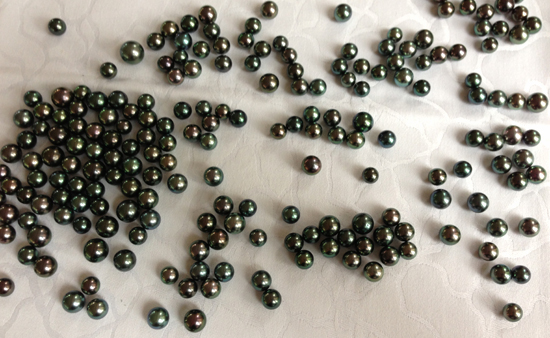
Sorting through such a large group of pearls such as the one above can be a daunting and rewarding challenge. It is important to think about the eventual use of the pearls in jewellery, their various grading qualities in terms of lustre, shape, colour and surface. Higher quality pearls will be used for earrings and pendants, whilst slightly less perfect pearls tend to be made into necklaces.
If everything looks good, the final stage of the auction is to make a sealed bid. A price in Japanese yen, dollars or euros (depending on the particular auction) is written on a small ticket and dropped into a ballot-like box.
A short wait follows, until the auction closes, before it is possible to see if your bid is ultimately successful.

Amongst our immediate favourites from this trip's selection were the beautiful dark Tahitian pearls picture above, with their gorgeous natural colours of peacock purple, cherry, aubergine, blue and green.
Over the next few months, we will be introducing these gems to Winterson.
-
What are the Best Pearls to Buy?
What are the Best Pearls to Buy?
With a heritage of working with pearls for over 50 years, one of the most frequent questions that we are asked at Winterson is what are the best pearls to buy. In this article we look at the most popular types of pearls and some tips to consider.
The classic pearl
The most popular image of the pearl is the classic round white pearl, draped in long elegant flowing strands, worn as a pretty stud earring or as a symbolic piece of jewellery for a new bride.
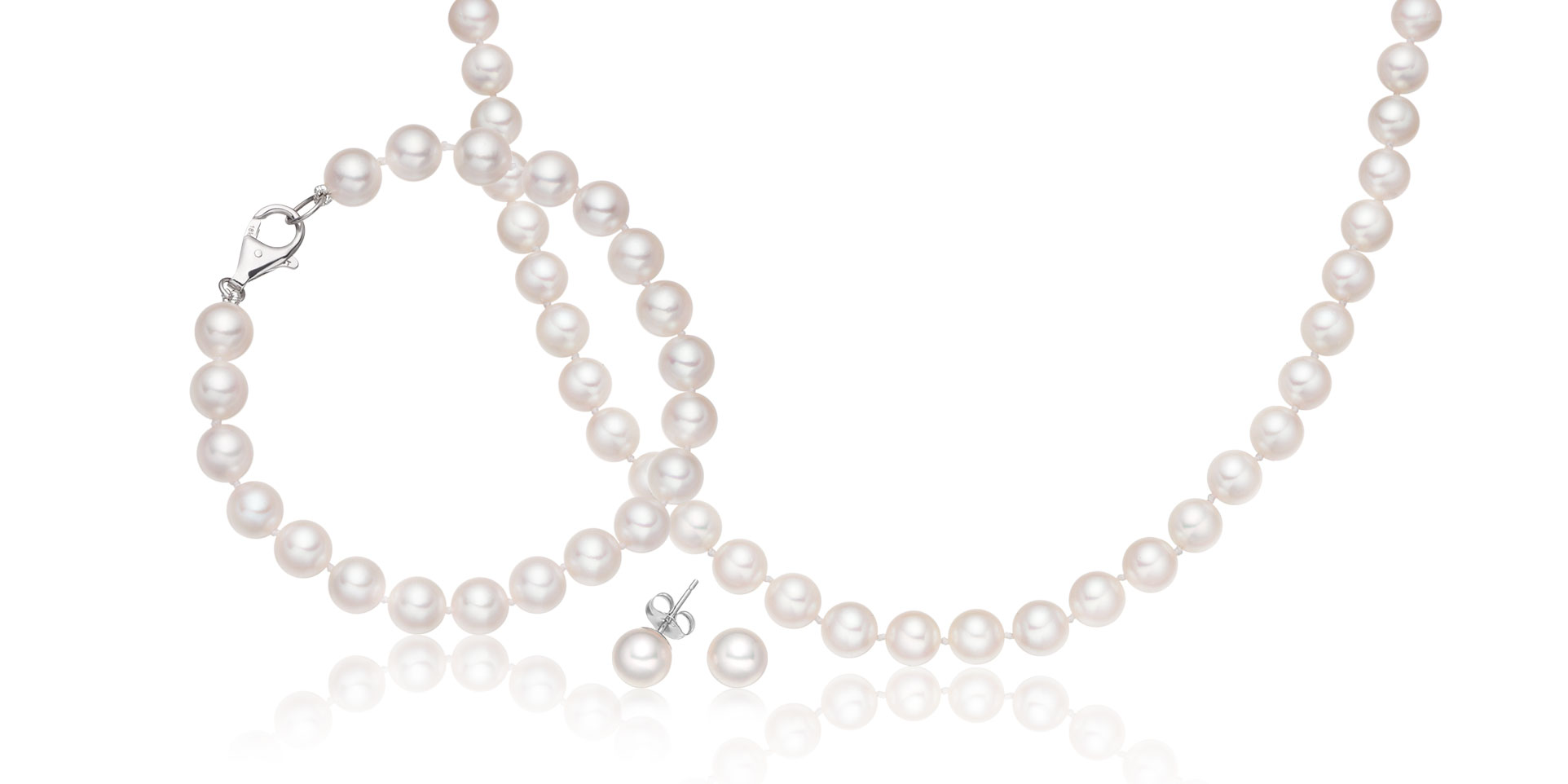
Image: Classic Akoya Pearl Jewellery Set
These styles will always be fashionable and versatile, but there are many other wonderful colours, sizes and shapes of pearls to buy. Before making a decision, it can be worthwhile exploring a little more about this beautiful gem.
Types of pearls
There are four main types of cultured pearl, including Freshwater pearls and three types of saltwater pearl known as Akoya pearls, Tahitian pearls and South Sea pearls.
Their size can range from as little as 1.5mm in diameter to as much as 20mm in diameter, with round, drop, oval and asymmetric baroque shapes. Their natural colours can include creamy whites, pastel shades of pink, peach and apricot, cooler hues of silver, grey, blue, purple and black and the warm opulence of gold.
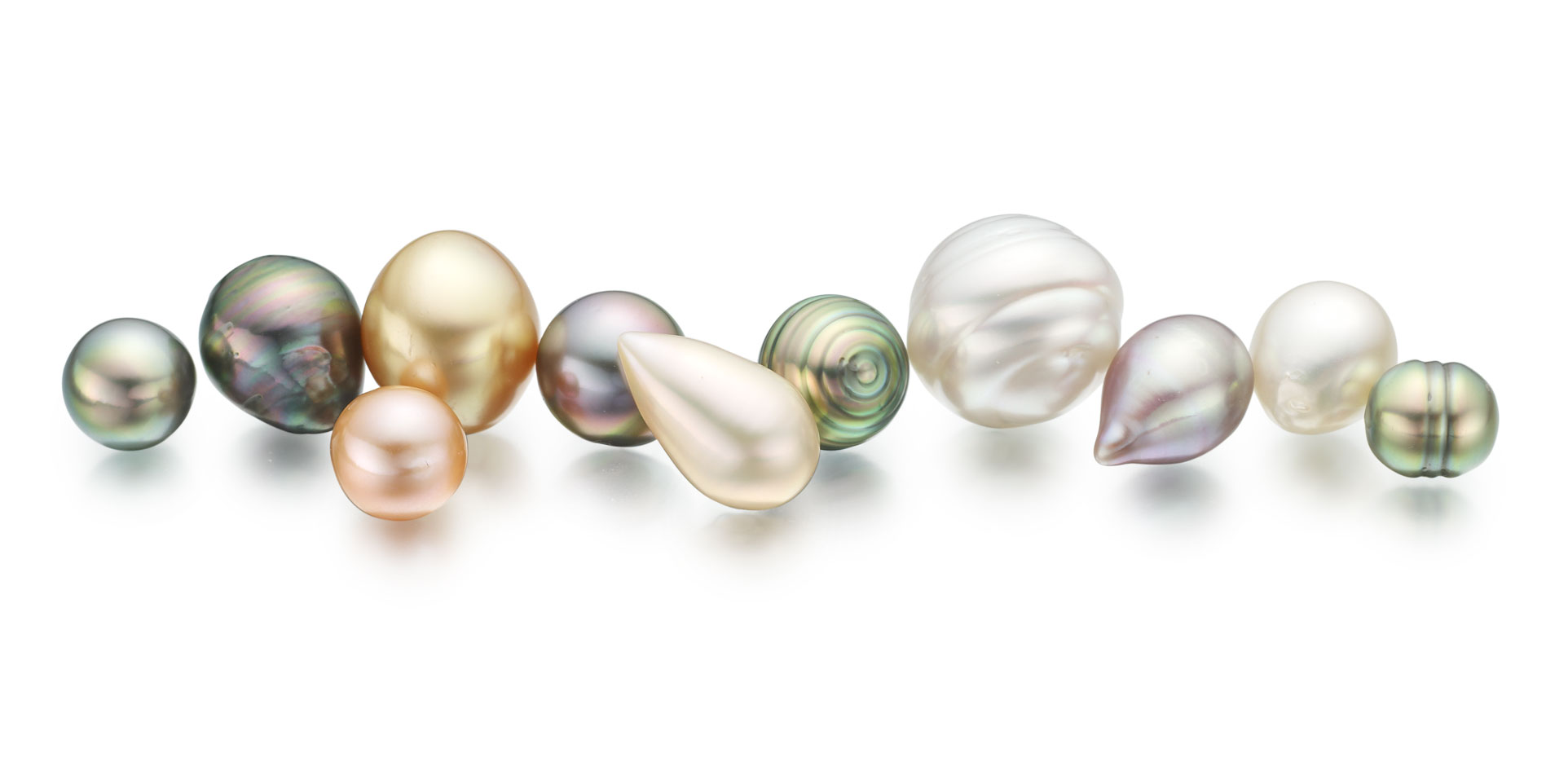
Image: Freshwater and Saltwater Pearl Shapes
Each pearl will also have been carefully cultured in a mussel or oyster for between 6 months and 3 years and their quality, uniqueness and rarity will increase their value. The difference in price between a small pearl with poor lustre and a perfectly round, excellent lustre pearl can be significant.
Is there a best pearl to buy?
There really is no straightforward answer as to 'what are the best pearls to buy' or 'what are the best pearls in the world'. If you are thinking of purchasing or wearing a piece of pearl jewellery, our advice would be to always consider the grading of the pearl, particularly its lustre, and how the design of the jewellery complements the pearl.
Pearl grading
Choose a piece of pearl jewellery that has been graded by an expert. There are several different grading systems used across the industry. We use the GIA Pearl Description System to describe the pearls in our jewellery, as this is one of the best known and reputable.
We also contract an independent organisation called Feefo to ask all our customers for their genuine feedback on each purchase from Winterson. This feedback is unedited by us and is published on our and Feefo's websites, acting as a marker of the quality you can expect from a Winterson pearl.
Do be careful when no information about a pearl is presented or when a pearl is described as being of AAAA quality.
The importance of lustre
Lustre is a grading factor that is used to describe how a pearl reflects light from its surface. This is one of a pearl's best qualities and is quite unlike any other gem. The best pearls to buy should have lustre that is sharp and mirror-like, catching the light and the eye.
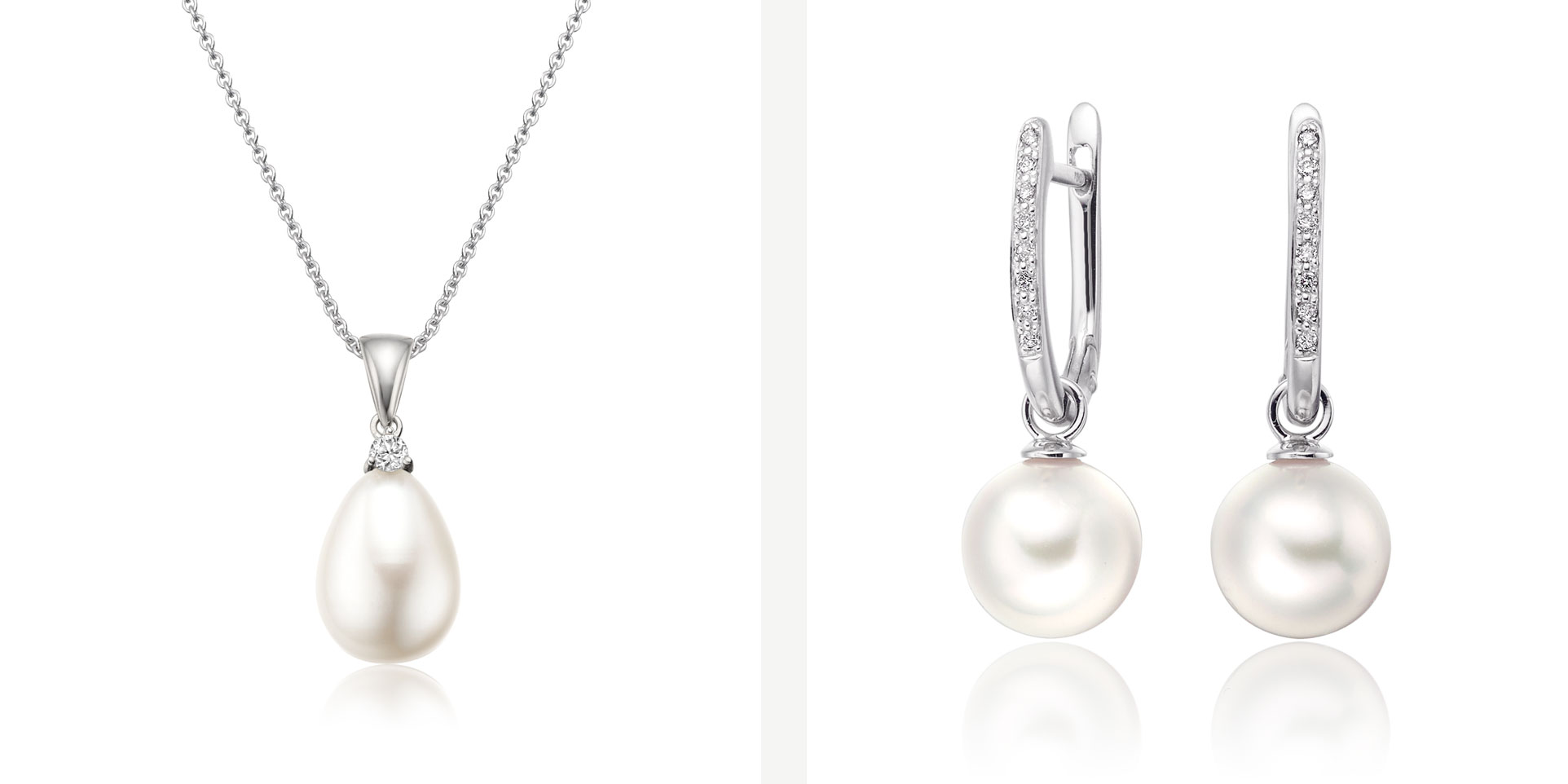
Image 1: Freshwater Drop Pearl and Diamond Pendant in White Gold
Image 2: White Gold Diamond Leverback And Akoya Pearl Earrings
One of our favourite pearls is the classic Akoya pearl, which is admired for its stunning lustre, as shown above with our Leverback earrings.
Beautiful jewellery design
Our third recommendation would be to choose a design that shows off the best features of the pearl. For example, we love the way that our Luna Rose Tahitian Pearl and Sapphire Ring, pictured above, contrasts the round shape and unusual aubergine colour of the Tahitian pearl with the rectangular shape and candy colour of the pink sapphire gem.
Using colourful gemstones to draw out the pearl’s myriad overtones is one technique that we use at Winterson. You can read more about our design inspirations and how we work with colour here.
If you have any questions about the best pearls to buy, our jewellery or our website, our Customer Care team would be happy to help you. Or learn more about the different Types of Pearls in our Guide to Buying Pearls here.
-
Pearl Fishing for the Oldest Natural Pearl
Pearl Fishing for the Oldest Natural Pearl
Earlier this year, French researchers discovered an ancient natural pearl at a coastal archaeological site in the Umm al-Quwain, one of the emirates of the United Arab Emirates. Confirming the finding with carbon-dating, the team from the Laboratoire Archéologies et Sciences de l'Antiquité has shown that pearl fishing and diving was taking place in the Persian Gulf as early as 5,500 BCE, far earlier than previously thought.
Before this important discovery in June 2012, it was thought that the oldest pearl in the world was the Jomon pearl, a Japanese archaeological find dating back more than 5,000 years old.
The natural pearl oyster beds of the Persian Gulf were a significant part of economic and cultural life for centuries, with Phoenician, Persian and Arab dhows and divers searching the sea waters of the Gulf for pearls. Bahrain was the centre of pearl fishing, and even today the emblem of the state includes two boats and a pearl.
The main pearl-producing oyster in the Gulf is Pinctada radiata, a small mollusc that can produce a white creamy colour pearl of around 4-6mm in size. Pearl divers would dive all day to depths of around 20 metres in search of these coveted gems.
The economic importance of pearls to the region is particularly apparent as pearls were its main export until as recently as the 1930s, when the oil industry and exploration in the Gulf states expanded and gave pearling fleets an alternative livelihood. It was also around this time that competition from the cultured Akoya pearl industry in Japan was increasing.
The CNRS team's discovery is surprising for extending the timeline of the region's association with pearls and for showing how pearls played a special role in society. The Umm al-Quwain pearl was found in a Neolithic grave site and might have been placed on the deceased's face or upper lip as part of a funeral ceremony.
Several Gulf countries such as Kuwait and Bahrain are interested in reviving their traditional pearl industry, but for now the Umm al-Quwain discovery is a reminder of a past age.
-
A Love of Pearls - Pearl Engagement Rings
A Love of Pearls - Pearl Engagement Rings
With the launch of our new range of pearl rings, we introduced our beautiful Akoya Pearl and Diamond White Gold Ring.
Impeccably finished in 18 carat white gold, the ring exquisitely highlights the grace and elegance of the pearl - the traditionally symbolic gemstone for new brides around the world to wear on their wedding day.
A BRIEF HISTORY OF THE ENGAGEMENT RING
The history and romance of giving rings is part of our wedding traditions, first being given in Ancient Egypt, Greece and Rome as symbols of love, the heart and ownership.
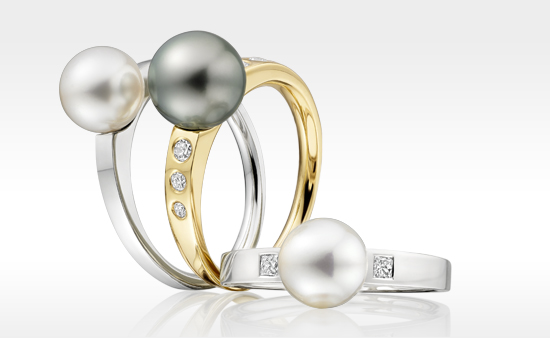
In 1477 the Archduke Maximilian of Austria is recorded to have presented Mary of Burgundy with the world's first diamond engagement ring. Families around Europe with significant wealth followed suit.
Until De Beers discovered large diamond deposits in South Africa in the late 19th century, however, diamonds were forever to just a few.
A TRADITION BEFORE DIAMONDS
Couples instead celebrated their engagement with a variety of different coloured gemstone and gold rings.
Engagement rings with sapphires, rubies, seed pearls and other gemstones were popular, as was the use of other metal alloys such as yellow gold and rose gold.
Victorian pearl engagement rings were simple or intricate in their design.
The solitaire diamond, set in six-pronged claw style called a Tiffany Setting in 1886, is still the classic engagement ring design today.
But more unusual gemstones and cuts are back in fashion. It is also popular for couples to choose a more individual style, to personalise a ring, or even design a bespoke piece of jewellery.
THE PEARL ENGAGEMENT RING
For our ring collection, this ring design features an Akoya pearl, a variety of saltwater pearl that can truly match the emotion of the occasion with its special lustre and pink-white colour.
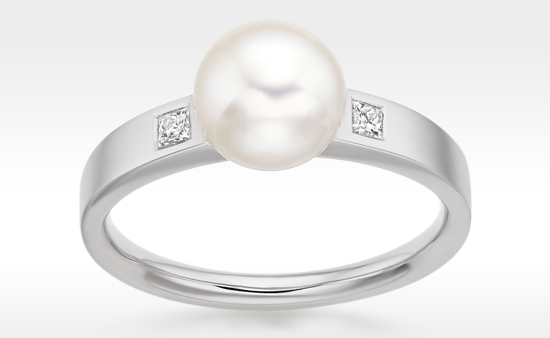
Two princess cut square white diamonds give the pearl an accent, whilst the flat court profile of the outside of the white gold band gives the ring a more contemporary styling.
A pearl engagement ring? Now that would be love.
-
Blue Pearl Secrets of the Abalone Sea Snail
Blue Pearl Secrets of the Abalone Sea Snail
Abalones are large sea snails with a secret. Brown and grey on the outside, and covered in seaweed, they hide a world of iridescent blue pearl colour inside their shells.
Abalones are a variety of marine gastropod, resembling a typical garden snail and carrying a single spiralled shell on its back. They live in shells that are up to 20 or 30cm in size and can survive in both cool and warm saltwater tidal zones.
Also considered a delicacy by some, Abalones are typically found off the coasts of Western USA, Mexico, Japan, Korea, South Africa, Australia and New Zealand. Although most live for 10 to 20 years, they can reach as much as 40 or 50 years in age.
Along with Conch snails and Melo melo, Abalones are also one of the few gastropods that are capable of producing pearls. As with pearls that are formed by a mollusc such as an oyster, an Abalone's pearls are made by depositing thousands of layers of an organic substance called nacre.
The surface of their inside shell, also called mother-of-pearl, shimmers with a kaleidoscope of blues, greens, pinks, silver and purple. The dark lines that weave across the surface of the shell, and linking its colours and texture together, are made with conchiolin, an organic protein that helps form a pearl's nacre.
Natural Abalone pearls are very rare. The unique colours of these blue pearls and their baroque horn shapes are highly sought after by jewellery collectors. One of the largest natural Abalone pearls ever found is the Big Pink Pearl, which was valued in 1991 at $4.7 million. Symmetrical round Abalone pearls are even more unusual and can take many years to form.
Attempts to produce cultured pearls with Abalones have been recorded since the late 19th century. The principal Abalone pearl farms today are in California and New Zealand, where the native paua is used to produce beautiful blue pearl mabe.
Culturing a saltwater pearl requires years of investment, technique, experimentation and pristine environmental conditions. But the challenges for Abalone pearl farmers are even harder as the animal is particularly sensitive to injury.
Blue pearl mabe are more frequently cultivated by pearl farmers as the procedure for making a blister pearl is more successful and less invasive to the Abalone. These beautiful cultured mabe pearls can be made into a unique collection of pendants, rings and earrings.
It would be almost impossible today to collect a sufficient quantity of round Abalone pearls to match and make into a conventional pearl necklace. Imagine how amazing and unique the colours of that piece of jewellery would be! -
The Rare Pink Pearls of Queen Conch
The Rare Pink Pearls of Queen Conch
Pearls can be formed by different types of molluscs other than saltwater oysters and freshwater mussels. One of the most celebrated and rarest types of natural pearls are the delicate pink pearls of Queen Conch. Shyly peeking out from underneath this shell are the eyestalks of an endangered mollusc that lives in the shallow and warm waters of the Caribbean Seas.
Queen Conch, also known as Lobatus gigas or Strombus gigas, is one of the largest living molluscs and can grow up to 30cm in size. Believed to have been around since the Pliocene Epoch, some 2.5 to 5 million years ago, Queen Conch has an average lifespan of between 20 and 30 years old. She likes to lunch in warm shallow sandy waters with easy access to food such as a seaweed salad.
The outside of the shell is in the shape of an elegant cone, which has a distinctive spiral of spines arranged in bands that become wider towards the opening of the shell. Between the shell and the mantle, the part of the mollusc that forms the shell, Queen Conch can also be found very occasionally to be safeguarding a small, precious pearl.
If you are familiar with the lustrous metallic shine of pearls that are produced in a nacre-producing mollusc, the appearance of a conch pearl is quite different. The pearl produced by a conch is a calcareous concretion composed of calcite and may exhibit a beautiful flame-like pattern on its surface. The colour of a conch pearl can also be a subtle pink, orange, brown, or white.
Conch pearls are usually just 2 to 3 millimetres in size, but it is possible to find baroque or oval shaped pearls of up to 3 centimetres. Round shaped conch pearls are almost never discovered today. As finding a natural conch pearl is rare and highly valued, Queen Conch pearls are relatively unknown to the jewellery buying public. It is particularly difficult to find conch pearls that can be matched for use in sets or earrings.
For years populations of conch in the Caribbean have been dramatically reduced by over-fishing, poaching and pollution. Today in most countries fishing and diving for Queen Conch is banned, but her future reign sadly remains a difficult one.